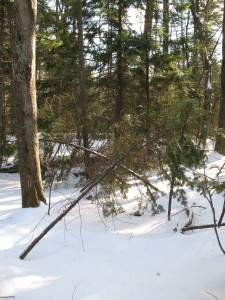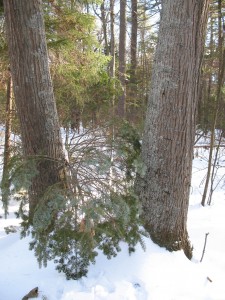There’s a story aslant in our local woods, its angles evident to any walker who pauses to consider. A number of the balsams and white pines under 20 feet in height are tipped variously in imitation of the better-known “drunken forests” of the far north. Those trees, living in the soil above permafrost, aim, as their peers world around do, at the sun. But sometimes – more often lately as the far north warms – when the permafrost melts in planes or pockets, the soil above it drops unevenly. And, of course, the trees follow. The treescape then resembles a geometry problem gone wild.
All of this came into focus after a little wondering while wandering the other day. What, I wondered, can be up with all these partially downed trees? The obvious suspect was our Thanksgiving snowstorm, a sullen fall of white cement that did the usual pruning of limbs and outing of power. Such evidence is everywhere in the neighborhood, awaiting spring clean-up. But the tipped trees took a little more thought and sifting of images; when I recalled a photo of a drunken forest, the story came clear.
Our lesser conifers caught the same heavy Thanksgiving snow as their bigger relations, and, as the storm wore on, they bowed before that weight and wind’s additions. Then, under the stress, the little neighborhoods of their root-balls began to give way, pull from the earth. “Root-ball” is really the wrong word for our conifers’ attachments, because it implies depth. Firs in our old glacial lands spread their root-fingers across the forest floor, rather than diving down where nutrients are spare and rocks are plentiful. Maybe root-hands is a better phrasing. And so, until the ground freezes and a locks in their holds on the land, little firs are prone to being partially uprooted, tipped by top-weight.
Just so our nearby drunken woods, now added headache hung over from the “revels” of our holiday storm.


